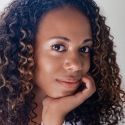Know your favorite foundation? Cool. Now what about your favorite foundation brush? Bronzing brush? Something to apply pigment to your eyes? No need panic, you’re a makeup beginner and that’s totally fine. You can stop right there—or, you can level up. With brushes designed to suit your needs. And...more. This is what I’d like to call makeup 201—not your entry course, but the next one over. More advanced, more tools, better results. So pick up your pencils and pay attention. Class is in session and pretty soon you’re going to need a bigger bag.
Primer that really primes
Let’s not begin this with an argument, but yes, you need a primer. More specifically, a primer that actually works—Tatcha’s. It didn’t make ITG’s Top 25 for no reason. A pea-size amount is enough to cover your entire face, eyelids included. Don’t let its pinky-white color and solid texture scare you off, it dries clear and feather-light. But the main reason you should start with it is because it makes all the following steps way easier. I’m talking less product and more control. You’ll be able to apply, blend, and smooth like you know what you’re doing. Your foundation won’t sit chalkily in one place on your face. Eyeshadow pigments will be easily distributed. What does Nike always say? Just…? Just… Well anyway, you know what to do.
Color corrector
Color correctors are fun because you get to become the Bob Ross of your own face. Undereye circles? Bring out the yellows and oranges. Redness? Hello green. Looking a bit sallow and washed out? Go for purple. Apply them under concealer or foundation so you don’t walk around like a human topography map. You don’t have to be super picky about the green or purple correctors, but you’ll want to be a bit more discerning when it comes to an undereye dark circle corrector—it needs to lay without pilling or creasing. My recommendation—Make Up For Ever’s HD Concealer for the lightest formula that actually erases dark circles (look for shades R22, R32, R40, and R50, which work as correctors). Also great—Bobbi Brown’s Intensive Skin Serum Corrector. Your decision.
Multiple foundation shades
Your face isn’t one color, so why should you stick to one foundation shade? These days I’m wearing somewhere in between two and three. A lighter one that I’m using as an undereye concealer, another one that’s a smidge darker for the center part of my face—nose, lower forehead, and cheeks—and an even darker one for the perimeter of my face. You don't need to be fancy about the foundation either—drugstore ones are fine. And even though this calls for more product, the result is incredibly realistic. After all, what better way to announce that you’re wearing a face full of makeup when it’s all one, flat seamless shade?
Setting spray
Only necessarily when you’ve used powder and you’re a little impatient. Powders will settle into your skin after an hour or so—setting sprays just speed up the process. Any one will do. They don’t even have to be called a setting spray! Mists are fine—and you might as well spritz something that smells nice. Rosewater...even plain old Evian water will work. A little spritz separates the makeup novices from the big leagues.
Tools!
To really ascend to the next level of makeup, you’re going to need to upgrade your tools. Got a Beautyblender? Good for you. In that case you’ll only need a few eye tools to reach serious beauty levels. But for the rest of you: pay close attention. Your upgraded brush kit should include a fan brush for highlighter, an angled brush for contour, a kabuki for bronzer, and a fluffy powder brush for... you guessed it. You don’t necessarily need a concealer brush—a few dabs from your finger will do, but when it comes to foundation, you’ll need to make sure yours is the right one. Liquid foundation? Use a brush called—shockingly—a foundation brush. It’s not a large brush, but its long synthetic fibers are good at moving foundation all around. Pressed powder foundations are better paired with a densely-packed, fluffy but not long-haired brush. And don’t forget a blush brush. A medium-size dome is all you need for powder blushes, and in the case of cream and liquid products, just use your hands.
When it comes to eyes, you’ll need at least three things. A small fluffy brush to deposit shadow all over, a longer-haired one to accentuate the crease, and a smudger so you can soften harsh eyeliner. Bonus points for a thin synthetic brush you can use to tap on glitter and shimmer as needed. And then you’re good to go. Until the next level of makeup education—onwards and upwards.
—Ashley Weatherford
Photo via ITG






